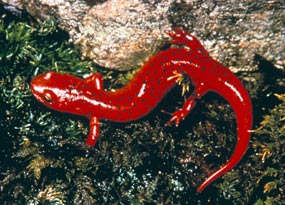 |
| Brightly colored black-chinned red salamanders are fairly common throughout the park at elevations up to 3,000 feet. |
 |
Two major groups of amphibians occur in the Great Smokies: the salamanders (30 species) and the frogs and toads (13 species). Amphibian checklist
Salamanders
The Great Smoky Mountains are known as the "Salamander Capital of the World!" Salamanders are an especially abundant and diverse group in the Great Smokies. In fact, the great majority of vertebrate (backboned) animals, including human visitors, in the park on any given day are salamanders.
Five families of salamanders are represented in the park: Cryptobranchidae, Proteidae, Salamandridae, Ambystomatidae, and Plethodontidae.
The southern Appalachian Mountains, including the Great Smokies, are a major center of evolutionary diversification for the family Plethodontidae, commonly known as the lungless salamanders. There are 24 species of lungless salamanders in the park. The family has undergone an extraordinary level of evolutionary diversification in the southern Appalachian Mountains. As their family name implies, these salamanders lack lungs. They "breathe" (exchange oxygen and carbon dioxide) through the walls of tiny blood vessels in their skin and linings of their mouths and throats. Lungless salamanders occur everywhere in the Great Smokies, in and along streams and under rocks, logs, and leaf litter in the forests.
Salamanders are commonly called "spring lizards" in the southern Appalachians. Lizards and salamanders are, however, very different sorts of animals: salamanders are amphibians while lizards are reptiles. The skins of salamander lack scales and are moist or slimy to the touch. Their eggs are surrounded by clear jelly. Lizards on the other hand, have scales on their skin, and are dry to the touch. They lay eggs with leathery shells.
Frogs
Adult frogs and toads are tailless amphibians with elongated hind legs that are adapted for jumping. Adult frogs and toads live in a variety of habitats, but all the species in the Great Smokies breed in water, and their life cycles all include an aquatic tadpole stage.
Amphibians in the Park
Amphibian live cycles are tremendously varied, and some are highly adapted for life on land. Amphibians as a group however, are semi-aquatic or at least moisture-loving creatures.
Adult amphibians are carnivorous. Frogs and many lungless salamanders use their tongues to capture small prey, while other salamanders capture their prey by grasping them in their jaws. Amphibians generally feed on any prey that is small enough to be subdued and eaten. Insects and other small invertebrate animals comprise the bulk of salamander and adult frog diets. Larval salamanders are also carnivorous, feeding mainly on small aquatic animals such as the immature stages of aquatic insects. Frog and toad larvae (tadpoles) are aquatic herbivores and scavengers, feeding on algae, aquatic plants, and bits of decaying organic matter.
| 





